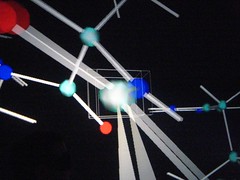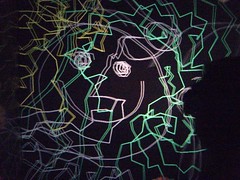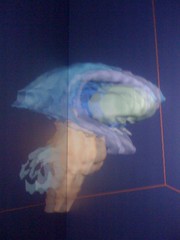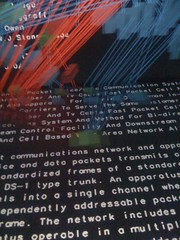 The conference started today with hands-on workshops for blogging beginners this morning and tours of some Research Triangle Park labs this afternoon. I had enormous fun, spending two hours at the DIVE, the Duke Immersive Virtual Environment. One of a half dozen or so CAVEs in the world, it was like SecondLife with glasses instead of a mouse. In fact, our first experience was an SL style woman walking down the hill across the room, then on to a bridge, from which she jumped. Our guide, Dr. Rachael Brady, then directed me to walk out onto the bridge, look over the side and jump. I did so, without the slightest fear of heights that I anticipated, and everyone else automatically went with me — since I was wearing the special glasses.
The conference started today with hands-on workshops for blogging beginners this morning and tours of some Research Triangle Park labs this afternoon. I had enormous fun, spending two hours at the DIVE, the Duke Immersive Virtual Environment. One of a half dozen or so CAVEs in the world, it was like SecondLife with glasses instead of a mouse. In fact, our first experience was an SL style woman walking down the hill across the room, then on to a bridge, from which she jumped. Our guide, Dr. Rachael Brady, then directed me to walk out onto the bridge, look over the side and jump. I did so, without the slightest fear of heights that I anticipated, and everyone else automatically went with me — since I was wearing the special glasses.
| The DIVE is a six-walled room, four sides, top, and floor, each with its own projectors displaying synchronized images, so that you have a sense of being surrounded by what ever. With the sterioscopic glasses, which rapidly switch on and off each eye, letting in a slightly different version to each eye, fooling the brain into a sense of depth, you lose the corners of the room, and start to feel — well — THERE.
|
 |
|
 |
One of the other DIVE tourists took the special glasses here, and also wielded a device that looked very much like a game controller. We found ourselves surounded by 3D representations of molecules. His handheld controller projected a virtual wand, which he could use to grab the molecules and move them around. He could also touch individual atoms in a certain way, and the system projected text-based information about the atom. |
| Here is another tourist, whose name I do not remember. She has the honor and privilege of working with some kind of budget branch of state government. But she is in a project to get teenage girls interested in science and math. I saw her take one of Rachael Brady’s business cards on the way out. This young woman is definately having a good time, on an open plain, staring a birds flying through the air. |
 |
 |
This rendering display some sort of protein. Brady explained it, but it was hard to concentrate, because the guy who was wielding the wand at that moment was practicing an intriguing feature. With the controller and wand, the operator can annotate parts of the virtual object. I’m sure he was making some sort of statement here. |
| I got to hold the wand during this segment and use it to examine a brain. Here, you are seeing the brain without the sterioscopic glasses, because, like all of these pictures, this was shot with a regular digital camera. With the glases on, it was a very solid (and sometimes transparent when programmed that way) looking object that floated in the middle of the room. I could grab it with the wand and move it back and forth, up and down, turn it around and upside down. There was a way that I could inject the wand into the brain, and as I moved it in and out, it displayed cross-sections, like an MRI. Fascinating!
|
 |

|
This rendering came from a very basic RDF, or metatagged file of patents related to computing, the companies that held them and the person most responsible. Because of the crossreferencing in the data, lines connected the items, and you could grab a patent, company, or person, with the wand, and then pull it out, the lines connecting them holding place, allowing you to examine relations. If you touched an object in a certain way, it’s data would appear, which is what you’re seeing to the left. |
 The conference started today with hands-on workshops for blogging beginners this morning and tours of some Research Triangle Park labs this afternoon. I had enormous fun, spending two hours at the DIVE, the Duke Immersive Virtual Environment. One of a half dozen or so CAVEs in the world, it was like SecondLife with glasses instead of a mouse. In fact, our first experience was an SL style woman walking down the hill across the room, then on to a bridge, from which she jumped. Our guide, Dr. Rachael Brady, then directed me to walk out onto the bridge, look over the side and jump. I did so, without the slightest fear of heights that I anticipated, and everyone else automatically went with me — since I was wearing the special glasses.
The conference started today with hands-on workshops for blogging beginners this morning and tours of some Research Triangle Park labs this afternoon. I had enormous fun, spending two hours at the DIVE, the Duke Immersive Virtual Environment. One of a half dozen or so CAVEs in the world, it was like SecondLife with glasses instead of a mouse. In fact, our first experience was an SL style woman walking down the hill across the room, then on to a bridge, from which she jumped. Our guide, Dr. Rachael Brady, then directed me to walk out onto the bridge, look over the side and jump. I did so, without the slightest fear of heights that I anticipated, and everyone else automatically went with me — since I was wearing the special glasses.






Where’s your geek cred, Dave? Not a single mention of experiencing the first working version of Star Trek’s Holodeck? 🙂
Sounds like it was a lot of fun!
Interesting about the Holodeck. Rachael said that they do not use that analogy any more, because most freshmen know nothing about it.
So very sad!
Dave, Thanks for touring the DiVE and blogging about it for your readers. We’ve just pointed to this post from the “Voices” section of our new online research magazine Duke Research. See http://research.duke.edu/category/voices/